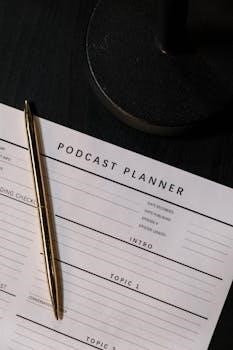DBT Cope Ahead Worksheet PDF⁚ A Comprehensive Guide
This guide explores the DBT Cope Ahead Worksheet, a valuable tool for mental health professionals and individuals alike․ This worksheet aids in preparing for stressful situations by planning and rehearsing coping mechanisms․ It’s a proactive approach to emotional regulation, rooted in Dialectical Behavior Therapy principles, enhancing resilience․

What is the DBT Cope Ahead Skill?
The DBT Cope Ahead skill is a proactive strategy within Dialectical Behavior Therapy (DBT) designed to prepare individuals for potentially challenging or stressful situations․ It involves anticipating difficult scenarios and planning effective coping mechanisms before the situation actually occurs․ This skill is rooted in the idea of rehearsing coping behaviors, thoughts, and actions in advance, allowing individuals to feel more prepared and less reactive when faced with difficult circumstances․ It is a fundamental aspect of DBT’s emotion regulation module, aiming to enhance one’s ability to manage distress without resorting to impulsive or harmful behaviors․ It encourages individuals to think through the upcoming event, identifying potential triggers and emotional responses․ By mentally rehearsing effective coping strategies, the Cope Ahead skill fosters a sense of control and promotes resilience in the face of adversity․ It’s about making a plan, considering skills already learned, and visualizing successful coping․ This allows individuals to apply their skills more effectively when needed, thereby reducing the likelihood of negative outcomes․ The skill integrates mindfulness and acceptance, encouraging individuals to approach stressful situations with a composed mindset․
The Purpose of the Cope Ahead Worksheet

The primary purpose of the DBT Cope Ahead Worksheet is to facilitate the practical application of the Cope Ahead skill․ It serves as a structured guide for individuals to systematically plan for upcoming stressful situations․ By using the worksheet, individuals are encouraged to break down a potentially challenging scenario into manageable components, focusing on identifying triggers, emotional responses, and effective coping strategies․ The worksheet provides a space to write out specific details about the situation, including the context, the emotions that are likely to arise, and the problem-solving skills they intend to utilize․ It prompts users to consider various aspects, such as what they will do, what they will say, and how they will approach the situation․ This process helps reduce anxiety and uncertainty by creating a tangible plan of action․ Furthermore, the worksheet incorporates elements of mindfulness and acceptance, encouraging individuals to approach the situation with a calm and non-judgmental perspective․ It serves as a tool for self-reflection and rehearsal, allowing individuals to mentally prepare for the challenges ahead․ The ultimate goal is to increase self-efficacy and reduce the likelihood of impulsive reactions, thereby promoting skillful coping and emotional well-being․

Key Components of a DBT Cope Ahead Worksheet

A typical DBT Cope Ahead Worksheet includes several key components designed to guide the user through a structured planning process․ Firstly, it features a section for describing the specific situation that is likely to prompt problem behavior, encouraging a detailed and fact-based account․ This often involves identifying triggers, the events or circumstances that lead to emotional distress․ Secondly, the worksheet prompts the user to identify potential emotional responses they might experience in the situation, such as anger, sadness, or anxiety․ This step helps to anticipate these emotions and prepare for them․ Thirdly, it includes space for planning and rehearsing coping strategies, encouraging the user to think about what specific actions, thoughts, and words they can use to navigate the situation effectively․ The worksheet will also guide users through the process of problem-solving, helping to consider different approaches to address the situation․ Furthermore, many worksheets include a section that encourages the use of relaxation techniques to promote calm and reduce the intensity of emotions․ The DBT Cope Ahead Worksheet often incorporates elements of mindfulness and acceptance, promoting a non-judgmental approach to the situation․ It may include a section for reflection after the situation has occurred to learn from the experience․
Identifying Triggers and Potential Emotional Responses
The initial step in utilizing a DBT Cope Ahead Worksheet involves a detailed examination of triggers and associated emotional responses․ This stage is crucial for effective planning and proactive coping․ Identifying triggers entails pinpointing the specific situations, events, or even internal thoughts that tend to provoke emotional distress or maladaptive behaviors․ These triggers can be varied, ranging from interpersonal conflicts to environmental factors or even personal anxieties about upcoming events․ For example, it could be an upcoming exam, a family gathering, or a specific type of social interaction․ The more precisely these triggers are identified, the more targeted the coping strategies can be․ Following trigger identification, the next step is to explore the emotional responses that typically surface․ This involves recognizing and naming the feelings that arise, such as anger, fear, sadness, or anxiety․ It is important to be specific about the intensity and nature of these emotions․ Recognizing the potential emotional reactions allows individuals to prepare for their occurrence and choose coping strategies that are best suited for that particular emotional response․ This step not only increases self-awareness but also sets the stage for planning to manage those feelings skillfully․
Planning and Rehearsing Coping Strategies
Once triggers and emotional responses are identified, the focus shifts to developing and rehearsing effective coping strategies․ This section of the DBT Cope Ahead Worksheet is dedicated to crafting a detailed plan of action․ It involves choosing specific coping mechanisms from the DBT skills repertoire that are most appropriate for the identified triggers and emotional responses․ These strategies may include mindfulness techniques, distress tolerance skills, emotion regulation skills, or interpersonal effectiveness skills․ The plan should be concrete and detailed, outlining exactly what actions, thoughts, and behaviors to engage in when faced with the anticipated situation․ It’s not enough just to know the skills; they need to be adapted to the specific scenario․ The rehearsing part is equally important․ This involves mentally practicing the chosen strategies․ It’s like a dress rehearsal for a play․ Individuals visualize themselves in the stressful situation and go through the steps of their coping plan in their minds․ This mental rehearsal helps to solidify the coping strategies and increase the likelihood that they will be effectively implemented when needed․ Furthermore, it provides an opportunity to troubleshoot potential problems and adjust the plan as necessary, ensuring a greater sense of preparedness and confidence․
The Role of Mindfulness and Acceptance
Mindfulness and acceptance play crucial roles within the DBT Cope Ahead Worksheet framework, underpinning its effectiveness․ Mindfulness, the practice of being fully present in the moment without judgment, is foundational in recognizing early signs of emotional distress․ By tuning into one’s physical sensations, thoughts, and feelings, individuals can identify triggers before they escalate․ This awareness is key in implementing coping strategies early on․ Acceptance, on the other hand, involves acknowledging and validating one’s current emotional state without attempting to change or suppress it․ This does not mean condoning harmful behaviors, but rather accepting emotions as they arise without judgment․ This acceptance paves the way for a more measured and skillful response․ Instead of reacting impulsively, individuals can create space for choosing how to act․ Integrating mindfulness and acceptance into the coping ahead process allows for a more compassionate and understanding approach to managing difficult situations․ It enables individuals to approach challenges with a sense of self-awareness and equanimity․ By combining these principles with planned coping strategies, the DBT Cope Ahead Worksheet becomes a powerful tool for building emotional resilience and promoting healthier responses to life’s inevitable stressors․ It emphasizes not only managing emotions but also relating to them in a way that fosters growth and well-being․
Using the Worksheet for Problem-Solving
The DBT Cope Ahead Worksheet serves as a structured framework for problem-solving, guiding users through a systematic approach to navigate challenging situations․ It encourages individuals to break down complex issues into smaller, more manageable parts․ Instead of reacting impulsively, the worksheet prompts reflection on the specific details of the problem situation, including potential triggers and emotional responses․ By identifying these key elements, users can develop targeted strategies for coping․ The worksheet facilitates the selection of appropriate problem-solving skills, such as clarifying the facts, determining what can be controlled, and brainstorming alternative solutions; It encourages users to consider the potential consequences of each solution, fostering a more thoughtful and informed approach․ Moreover, the worksheet promotes a proactive stance by planning and rehearsing the implementation of chosen strategies․ This mental rehearsal helps in anticipating potential difficulties and developing contingency plans․ By systematically addressing the problem and rehearsing coping mechanisms, the worksheet not only reduces the likelihood of impulsive reactions but also fosters a sense of self-efficacy․ The DBT Cope Ahead Worksheet is a powerful tool for enhancing problem-solving skills, promoting resilience, and fostering a more adaptive response to life’s inevitable challenges․ It provides a roadmap for navigating difficult situations effectively․
Benefits of Using the Cope Ahead Worksheet
The Cope Ahead Worksheet offers numerous benefits, primarily focusing on proactive emotional regulation and enhanced coping skills․ Firstly, it fosters a sense of preparedness, reducing anxiety associated with anticipated stressful situations․ By planning and rehearsing coping strategies, individuals gain confidence in their ability to handle challenges effectively․ This proactive approach minimizes impulsive reactions and promotes more thoughtful responses․ The worksheet also facilitates the development of problem-solving skills, enabling users to approach difficult situations systematically․ Through identifying triggers and potential emotional responses, individuals gain a deeper understanding of their own patterns․ This self-awareness is crucial for making informed decisions about which coping mechanisms to utilize․ Furthermore, the worksheet encourages the use of mindfulness and acceptance, reducing the tendency to struggle against unpleasant emotions․ By practicing these skills, individuals learn to tolerate distress without resorting to maladaptive behaviors․ The rehearsal aspect of the worksheet solidifies new coping strategies, transforming them from abstract ideas into concrete actions․ This process enhances the likelihood that these skills will be utilized effectively in real-life situations․ Ultimately, the Cope Ahead Worksheet empowers individuals to take control of their emotional responses, fostering resilience and promoting overall well-being․ It’s a valuable tool for those seeking to navigate life’s challenges with greater confidence and skill․ The worksheet serves as a guide for building self-efficacy․
Adapting the Worksheet for Different Scenarios
The versatility of the DBT Cope Ahead Worksheet lies in its adaptability to various scenarios and individual needs․ While the core structure remains consistent, the specific content can be tailored to address diverse situations, whether they involve interpersonal conflicts, academic pressures, or internal emotional struggles․ For instance, when facing an upcoming exam, the worksheet might focus on identifying triggers related to test anxiety and rehearsing strategies for managing those emotions during the exam․ Conversely, when anticipating a family gathering, the worksheet might emphasize coping skills for navigating difficult conversations and maintaining personal boundaries․ The key is to customize the trigger identification, emotional response analysis, and coping strategy sections to reflect the unique challenges of each situation․ Moreover, the worksheet can be adapted to suit different learning styles and preferences․ Some individuals may prefer to write detailed plans, while others may find it more beneficial to create visual representations or use verbal rehearsal․ Therapists can also use the worksheet to guide clients through specific steps, providing support and feedback․ For couples or families, the worksheet can be used collaboratively, encouraging shared understanding and mutual coping strategies․ The flexible nature of the worksheet allows for ongoing adjustments and revisions, ensuring its continued relevance and effectiveness․ This adaptability makes the Cope Ahead Worksheet a powerful tool for promoting resilience across diverse life circumstances․ The worksheet’s structure encourages personalized planning․
Reflection and Future Planning
Reflection forms a crucial part of the Cope Ahead process, enabling individuals to learn from their experiences and refine their strategies for future challenges․ After utilizing the worksheet in a real-life situation, it’s essential to review its effectiveness․ Consider which coping mechanisms proved helpful and which did not․ This reflective process involves analyzing the accuracy of the initial trigger identification, the intensity of the emotional response, and the effectiveness of the rehearsed coping skills․ By discussing what worked well, what didn’t, and what could be improved upon, individuals can gain valuable insights for future planning․ This iterative approach transforms the Cope Ahead Worksheet from a one-time tool into a dynamic resource that evolves with the individual’s needs․ The insights gleaned during reflection directly inform future planning․ If a particular coping strategy was ineffective, the worksheet can be adjusted to include alternative approaches or modifications․ If certain triggers were underestimated, the planning can be revised to address these more effectively․ This continuous process of evaluation and adjustment helps build resilience and promotes self-awareness․ The worksheet, therefore, becomes not just a tool for coping but also for self-discovery․ This proactive and reflective approach empowers individuals to navigate life’s challenges with greater skill and confidence․ It’s important to view this as an ongoing process, not a destination․
Where to Find DBT Cope Ahead Worksheets
Accessing DBT Cope Ahead Worksheets is relatively straightforward, as numerous resources cater to both mental health professionals and individuals seeking self-help tools․ Many therapists and counselors specializing in Dialectical Behavior Therapy (DBT) often provide these worksheets as part of their treatment plans․ These professionals may offer physical copies or digital versions, often in PDF format, which can be easily printed or filled out electronically․ Online platforms dedicated to mental health resources are another valuable source․ Websites and forums related to DBT frequently provide downloadable worksheets, sometimes free of charge or as part of a paid subscription․ Additionally, educational institutions, such as universities with psychology departments, may offer these resources through their community outreach programs or counseling centers․ Mental health clinics and support groups also often distribute DBT materials, including the Cope Ahead Worksheet․ Furthermore, some mobile applications and software designed for mental well-being include interactive versions of these worksheets, making them accessible on the go; It is important to ensure that the source is reputable and that the worksheets are designed in accordance with DBT principles․ When searching online, using specific keywords such as “DBT Cope Ahead Worksheet PDF” will increase the chances of finding relevant materials․ Remember to evaluate the credibility of the source before downloading any materials․ Always consult with a qualified mental health professional for guidance on using these worksheets effectively․
